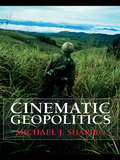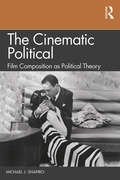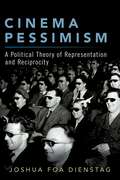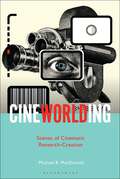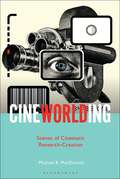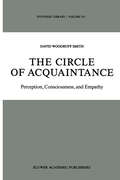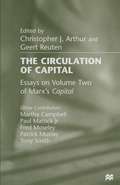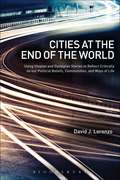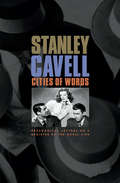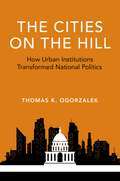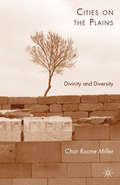- Table View
- List View
Cinematic Ethics: Exploring Ethical Experience through Film
by Robert SinnerbrinkHow do movies evoke and express ethical ideas? What role does our emotional involvement play in this process? What makes the aesthetic power of cinema ethically significant? Cinematic Ethics: Exploring Ethical Experience through Film addresses these questions by examining the idea of cinema as a medium of ethical experience with the power to provoke emotional understanding and philosophical thinking. In a clear and engaging style, Robert Sinnerbrink examines the key philosophical approaches to ethics in contemporary film theory and philosophy using detailed case studies of cinematic ethics across different genres, styles, and filmic traditions. Written in a lucid and lively style that will engage both specialist and non-specialist readers, this book is ideal for use in the academic study of philosophy and film. Key features include annotated suggestions for further reading at the end of each chapter and a filmography of movies useful for teaching and researching cinematic ethics.
Cinematic Geopolitics
by Michael J. ShapiroIn recent years, film has been one of the major genres within which the imaginaries involved in mapping the geopolitical world have been represented and reflected upon. In this book, one of America's foremost theorists of culture and politics treats those aspects of the "geopolitical aesthetic" that must be addressed in light of both the post cold war and post 9/11 world and contemporary film theory and philosophy. Beginning with an account of his experience as a juror at film festival’s, Michael J. Shapiro’s Cinematic Geopolitics analyzes the ways in which film festival space and both feature and documentary films function as counter-spaces to the contemporary "violent cartography" occasioned by governmental policy, especially the current "war on terror." Influenced by the cinema-philosophy relationship developed by Gilles Deleuze and the politics of aesthetics thinking of Jacques Ranciere, the book’s chapters examines a range of films from established classics like the Deer Hunter and the Battle of Algiers to contemporary films such as Dirty Pretty Things and the Fog of War. Shapiro’s use of philosophical and theoretical works makes this cutting edge examination of film and politics essential reading for all students and scholars with an interest in film and politics.
Cinematic Geopolitics
by Michael J. ShapiroIn recent years, film has been one of the major genres within which the imaginaries involved in mapping the geopolitical world have been represented and reflected upon. In this book, one of America's foremost theorists of culture and politics treats those aspects of the "geopolitical aesthetic" that must be addressed in light of both the post cold war and post 9/11 world and contemporary film theory and philosophy. Beginning with an account of his experience as a juror at film festival’s, Michael J. Shapiro’s Cinematic Geopolitics analyzes the ways in which film festival space and both feature and documentary films function as counter-spaces to the contemporary "violent cartography" occasioned by governmental policy, especially the current "war on terror." Influenced by the cinema-philosophy relationship developed by Gilles Deleuze and the politics of aesthetics thinking of Jacques Ranciere, the book’s chapters examines a range of films from established classics like the Deer Hunter and the Battle of Algiers to contemporary films such as Dirty Pretty Things and the Fog of War. Shapiro’s use of philosophical and theoretical works makes this cutting edge examination of film and politics essential reading for all students and scholars with an interest in film and politics.
Cinematic Modernism and Contemporary Film: Aesthetics and Narrative in the International Art Film
by Howard FinnCinema was the most important new artistic medium of the twentieth century and modernism was the most important new aesthetic movement across the arts in the twentieth century. However, what exactly is the relationship between cinema and modernism? Cinematic Modernism and Contemporary Film explores how in the early twentieth century cinema came to be seen as one of the new technologies which epitomised modernity and how cinema itself reflected ideas, hopes and fears concerning modern life. Howard Finn examines the emergence of a new 'international style' of cinema, combining a poetic aesthetic of the image with genre-based fictional narrative and documentary realism. He provides concise accounts of how theorists such as André Bazin, Siegfried Kracauer, Gilles Deleuze and Jacques Rancière have discussed this cinematic aesthetic, clarifying debates over terms such as 'realism', 'classical' and 'avant-garde' as well as recent controversies over terms such as 'slow cinema' and 'vernacular modernism'. He further argues the influence of modernism through close readings of many contemporary films, including films by Abbas Kiarostami, Béla Tarr, Jia Zhangke, and Angela Schanelec.Drawing on a broad range of examples, including Soviet montage, Italian neorealism, postwar new waves and the 'new cinema' of Taiwan and Iran, this book explores the cultural significance of modernism and its lasting influence over cinema.
Cinematic Modernism and Contemporary Film: Aesthetics and Narrative in the International Art Film
by Howard FinnCinema was the most important new artistic medium of the twentieth century and modernism was the most important new aesthetic movement across the arts in the twentieth century. However, what exactly is the relationship between cinema and modernism? Cinematic Modernism and Contemporary Film explores how in the early twentieth century cinema came to be seen as one of the new technologies which epitomised modernity and how cinema itself reflected ideas, hopes and fears concerning modern life. Howard Finn examines the emergence of a new 'international style' of cinema, combining a poetic aesthetic of the image with genre-based fictional narrative and documentary realism. He provides concise accounts of how theorists such as André Bazin, Siegfried Kracauer, Gilles Deleuze and Jacques Rancière have discussed this cinematic aesthetic, clarifying debates over terms such as 'realism', 'classical' and 'avant-garde' as well as recent controversies over terms such as 'slow cinema' and 'vernacular modernism'. He further argues the influence of modernism through close readings of many contemporary films, including films by Abbas Kiarostami, Béla Tarr, Jia Zhangke, and Angela Schanelec.Drawing on a broad range of examples, including Soviet montage, Italian neorealism, postwar new waves and the 'new cinema' of Taiwan and Iran, this book explores the cultural significance of modernism and its lasting influence over cinema.
Cinematic Philosophy
by Tal S. ShamirIn this book, Tal S. Shamir sets out to identify cinema as a novel medium for philosophy and an important way of manifesting and developing philosophical thought. The volume presents a comprehensive analysis of the nature of philosophy’s potential—or, more strongly put, its need—to be manifested cinematically. Drawing on the fields of cinema, philosophy, and media studies, Cinematic Philosophy adds film to the traditional list of ways through which philosophy can be created, concentrating on the unique potential of the cinematic medium to effectively put forward and create philosophy. In the process, the book opens up innovative horizons for new types of knowledge and wisdom grounded in contemporary contexts and philosophical thought. Philosophy, best characterized as the love of wisdom, is not dependent on a specific medium nor solely situated within written text or oral lectures. Shamir asserts that philosophy can, should, and must be manifested and identified in a range of different platforms.
The Cinematic Political: Film Composition as Political Theory
by Michael J. ShapiroIn this book, Michael J. Shapiro stages a series of pedagogical encounters between political theory, represented as a compositional challenge, and cinematic texts, emphasizing how to achieve an effective research paper/essay by heeding the compositional strategies of films. The text’s distinctiveness is its focus on the intermediation between two textual genres. It is aimed at providing both a conceptual introduction to the politics of aesthetics and a guide to writing strategies. In its illustrations of encounters between political theory and cinema, the book’s critical edge is its emphasis on how to intervene in cinematic texts with innovative conceptual frames in ways that challenge dominant understandings of life worlds. The Cinematic Political is designed as a teaching resource that introduces students to the relationship between film form and political thinking. With diverse illustrative investigations, the book instructs students on how to watch films with an eye toward writing a research paper in which a film (or set of films) constitutes the textual vehicle for political theorizing.
The Cinematic Political: Film Composition as Political Theory
by Michael J. ShapiroIn this book, Michael J. Shapiro stages a series of pedagogical encounters between political theory, represented as a compositional challenge, and cinematic texts, emphasizing how to achieve an effective research paper/essay by heeding the compositional strategies of films. The text’s distinctiveness is its focus on the intermediation between two textual genres. It is aimed at providing both a conceptual introduction to the politics of aesthetics and a guide to writing strategies. In its illustrations of encounters between political theory and cinema, the book’s critical edge is its emphasis on how to intervene in cinematic texts with innovative conceptual frames in ways that challenge dominant understandings of life worlds. The Cinematic Political is designed as a teaching resource that introduces students to the relationship between film form and political thinking. With diverse illustrative investigations, the book instructs students on how to watch films with an eye toward writing a research paper in which a film (or set of films) constitutes the textual vehicle for political theorizing.
CINEMA PESSIMISM C: A Political Theory of Representation and Reciprocity
by Joshua Foa DienstagAesthetic and political representation are often treated separately, but this book argues that film offers a unique perspective through which to understand the dangers to equality and freedom that lurk in representative politics. The potential problems of representative democracy have long been debated: does it cultivate apathy and discourage citizen participation? What does it mean to be faithfully or well represented in a democracy? And how can appropriate, meaningful representation be achieved? Here, these questions are addressed from a new perspective. Representation, Joshua Foa Dienstag argues, can create the illusion of freedom and reciprocity in place of the real thing, and in both cinema and politics, what gives us pleasure is not the same as what secures or supports our existence as free and equal citizens. As this book shows, there are political dangers not visible within the current debates around democratic representation, dangers we can better understand and help to minimize by considering the way that human beings interact, emotionally, with their filmic representations. Dienstag looks at a series of films that directly confront issues of representation (Her, Blade Runner, The Man Who Shot Liberty Valance, Melancholia, and the Up documentary series) to diagnose these hazards and consider how best to respond to them. Each chapter looks at a specific film as emblematic of a different conception or problem of representation often ignored by mainstream political debates (such as reciprocity, happiness, boundaries, evil) to show that the relationship between representation and freedom is fraught with tension. This book continues Dienstag's earlier groundbreaking work on philosophical pessimism, understood not as something despairing, but as a rejection of the idea that these necessary tensions can be cured. Ultimately, Dienstag seeks to defend a kind of pessimistic politics that might produce a better sort of democratic representation than what we have today.
CineWorlding: Scenes of Cinematic Research-Creation
by Michael B. MacDonaldUsing cine-ethnomusicology as a focus, Cineworlding introduces readers to ways of thinking eco-cinematically. Screens are omnipresent, we carry digital cinema production equipment in our pockets, but this screen-based technological revolution has barely impacted social science scholarship. Mixing existential phenomenological fiction about social science digital cinema research practice followed by theoretical reflection and discussion of methods, this book has emerged from a decade-long inquiry into cineworlding and a desire to help others produce digital media to engage creatively with the digital networks that surround us.
CineWorlding: Scenes of Cinematic Research-Creation
by Michael B. MacDonaldUsing cine-ethnomusicology as a focus, Cineworlding introduces readers to ways of thinking eco-cinematically. Screens are omnipresent, we carry digital cinema production equipment in our pockets, but this screen-based technological revolution has barely impacted social science scholarship. Mixing existential phenomenological fiction about social science digital cinema research practice followed by theoretical reflection and discussion of methods, this book has emerged from a decade-long inquiry into cineworlding and a desire to help others produce digital media to engage creatively with the digital networks that surround us.
The Circle of Acquaintance: Perception, Consciousness, and Empathy (Synthese Library #205)
by D.W SmithCircles Disturbed: The Interplay of Mathematics and Narrative
by Apostolos Doxiadis Barry MazurCircles Disturbed brings together important thinkers in mathematics, history, and philosophy to explore the relationship between mathematics and narrative. The book's title recalls the last words of the great Greek mathematician Archimedes before he was slain by a Roman soldier--"Don't disturb my circles"--words that seem to refer to two radically different concerns: that of the practical person living in the concrete world of reality, and that of the theoretician lost in a world of abstraction. Stories and theorems are, in a sense, the natural languages of these two worlds--stories representing the way we act and interact, and theorems giving us pure thought, distilled from the hustle and bustle of reality. Yet, though the voices of stories and theorems seem totally different, they share profound connections and similarities. A book unlike any other, Circles Disturbed delves into topics such as the way in which historical and biographical narratives shape our understanding of mathematics and mathematicians, the development of "myths of origins" in mathematics, the structure and importance of mathematical dreams, the role of storytelling in the formation of mathematical intuitions, the ways mathematics helps us organize the way we think about narrative structure, and much more. In addition to the editors, the contributors are Amir Alexander, David Corfield, Peter Galison, Timothy Gowers, Michael Harris, David Herman, Federica La Nave, G.E.R. Lloyd, Uri Margolin, Colin McLarty, Jan Christoph Meister, Arkady Plotnitsky, and Bernard Teissier.
Circles Disturbed: The Interplay of Mathematics and Narrative
by Apostolos Doxiadis Barry MazurCircles Disturbed brings together important thinkers in mathematics, history, and philosophy to explore the relationship between mathematics and narrative. The book's title recalls the last words of the great Greek mathematician Archimedes before he was slain by a Roman soldier--"Don't disturb my circles"--words that seem to refer to two radically different concerns: that of the practical person living in the concrete world of reality, and that of the theoretician lost in a world of abstraction. Stories and theorems are, in a sense, the natural languages of these two worlds--stories representing the way we act and interact, and theorems giving us pure thought, distilled from the hustle and bustle of reality. Yet, though the voices of stories and theorems seem totally different, they share profound connections and similarities. A book unlike any other, Circles Disturbed delves into topics such as the way in which historical and biographical narratives shape our understanding of mathematics and mathematicians, the development of "myths of origins" in mathematics, the structure and importance of mathematical dreams, the role of storytelling in the formation of mathematical intuitions, the ways mathematics helps us organize the way we think about narrative structure, and much more. In addition to the editors, the contributors are Amir Alexander, David Corfield, Peter Galison, Timothy Gowers, Michael Harris, David Herman, Federica La Nave, G.E.R. Lloyd, Uri Margolin, Colin McLarty, Jan Christoph Meister, Arkady Plotnitsky, and Bernard Teissier.
Circuits in the Brain: A Model of Shape Processing in the Primary Visual Cortex
by Charles LegéndyDr. Charles Legéndy’s Circuits in the Brain: A Model of Shape Processing in the Primary Visual Cortex is published at a time marked by unprecedented advances in experimental brain research which are, however, not matched by similar advances in theoretical insight. For this reason, the timing is ideal for the appearance of Dr. Legéndy’s book, which undertakes to derive certain global features of the brain directly from the neurons. Circuits in the Brain, with its “relational firing” model of shape processing, includes a step-by-step development of a set of multi-neuronal networks for transmitting visual relations, using a strategy believed to be equally applicable to many aspects of brain function other than vision. The book contains a number of testable predictions at the neuronal level, some believed to be accessible to the techniques which have recently become available. With its novel approach and concrete references to anatomy and physiology, the monograph promises to open up entirely new avenues of brain research, and will be particularly useful to graduate students, academics, and researchers studying neuroscience and neurobiology. In addition, since Dr. Legéndy’s book succeeds in achieving a clean logical presentation without mathematics, and uses a bare minimum of technical terminology, it may also be enjoyed by non-scientists intrigued by the intellectual challenge of the elegant devices applied inside our brain. The book is uniquely self-contained; with more than 120 annotated illustrations it goes into full detail in describing all functional and theoretical concepts on which it builds.
The Circulation of Capital: Essays on Volume Two of Marx’s Capital
by Christopher J. Arthur Geert ReutenThe second volume of Marx's Capital is entitled The Circulation of Capital . Here a collection of original essays, by internationally known scholars, treat its themes, bringing to bear on all its parts the latest textual findings, methodological resources and accumulated knowledge of Marxian theory. The result repairs the unjustified neglect of this volume in the literature on Marx and will awaken new interest in it among economists, philosophers and social theorists.
Citation Classics from the Journal of Business Ethics: Celebrating the First Thirty Years of Publication (Advances in Business Ethics Research #2)
by Alex C. Michalos and Deborah C. PoffThe Journal of Business Ethics was founded by Alex C. Michalos and Deborah C. Poff and published its first issue in March 1982. It is the most frequently cited business ethics journal in the world. The Journal has always offered a multi-disciplinary and international public forum for the discussion of issues concerning the interaction of successful business and moral virtue. Its authors and readers are primarily scholars and students in social sciences and philosophy , with special interests in the interaction of these disciplines with business or corporate responsibility. Since the field of business ethics grew simultaneously with the growth of the Journal, a collection of its most cited articles is tantamount to a collection of the articles that had the greatest influence in defining the field over its first 30 years of development. In this anniversary volume, an overview of citation classics from the Journal is presented, the 33 most frequently cited articles are reproduced and brief reflections on the impact of the Journal on the field are given from over 100 scholars who authored citation classics and/or distinguished papers, as well as those who served on the Editorial Board and/or are recognized as leaders in the field.
Cities at the End of the World: Using Utopian and Dystopian Stories to Reflect Critically on our Political Beliefs, Communities, and Ways of Life
by David J. LorenzoThis book undertakes a critical examination of contemporary political problems through discussions of three utopian and three dystopian texts.Selected stories from Morris, Orwell, More, Bellamy, Neville, and Zamyatin are used to generate questions about fundamental economic, political, and social problems, human nature, and conceptions of the good life. This unique work is an exceptional resource for all students of political philosophy and utopian literature, as well as for general readers interested in political affairs.
Cities at the End of the World: Using Utopian and Dystopian Stories to Reflect Critically on our Political Beliefs, Communities, and Ways of Life
by David J. LorenzoThis book undertakes a critical examination of contemporary political problems through discussions of three utopian and three dystopian texts.Selected stories from Morris, Orwell, More, Bellamy, Neville, and Zamyatin are used to generate questions about fundamental economic, political, and social problems, human nature, and conceptions of the good life. This unique work is an exceptional resource for all students of political philosophy and utopian literature, as well as for general readers interested in political affairs.
Cities of the Gods: Communist Utopias in Greek Thought
by Doyne DawsonModern studies of classical utopian thought are usually restricted to the Republic and Laws of Plato, producing the impression that Greek speculation about ideal states was invariably authoritarian and hierarchical. This book, however, sets Plato in the context of the whole ancient tradition of philosophical utopia. It distinguishes two types of Greek utopia, relating both to the social and the political background of Greece between the fifth and third centuries B.C. There was a lower utopianism, meant for literal implementation, which arose from the Greek colonizing movement, and a higher theoretical form which arose from the practical utopias. Dawson focuses on the higher utopianism, whose main theme was total communism in property and family. He attempts to reconstruct the lost utopian works of the Stoics, arguing that their ideal state was universal and egalitarian, in deliberate contrast to the hierarchical and militaristic utopia of Plato; and that both theories were intended to bring about long-range social reform, though neither was meant for direct implementation. Dawson offers an explanation for the disappearance of the utopian tradition in the later Hellenistic age. A final chapter traces the survival of communistic ideas in early Christianity.
Cities of Words: Pedagogical Letters On A Register Of The Moral Life
by Stanley CavellThis text - which presents a course of lectures Cavell gave several times toward the end of his teaching career at Harvard - links masterpieces of moral philosophy and classic Hollywood comedies to fashion a new way of looking at our lives and learning to live with ourselves.
Cities of Words: Pedagogical Letters on a Register of the Moral Life
by Stanley CavellThis book--which presents a course of lectures Cavell presented several times toward the end of his teaching career at Harvard--links masterpieces of moral philosophy and classic Hollywood comedies to fashion a new way of looking at our lives and learning to live with ourselves.
The Cities on the Hill: How Urban Institutions Transformed National Politics (Studies in Postwar American Political Development)
by Thomas K. OgorzalekOver the second half of the 20th century, American politics was reorganized around race as the tenuous New Deal coalition frayed and eventually collapsed. What drove this change? In The Cities on the Hill, Thomas Ogorzalek argues that the answer lies not in the sectional divide between North and South, but in the differences between how cities and rural areas govern themselves and pursue their interests on the national stage. Using a wide range of evidence from Congress and an original dataset measuring the urbanicity of districts over time, he shows how the trajectory of partisan politics in America today was set in the very beginning of the New Deal. Both rural and urban America were riven with local racial conflict, but beginning in the 1930s, city leaders became increasingly unified in national politics and supportive of civil rights, changes that sowed the seeds of modern liberalism. As Ogorzalek powerfully demonstrates, the red and blue shades of contemporary political geography derive more from rural and urban perspectives than clean state or regional lines-but local institutions can help bridges the divides that keep Americans apart.
CITIES ON THE HILL PAPD C: How Urban Institutions Transformed National Politics (Studies in Postwar American Political Development)
by Thomas K. OgorzalekOver the second half of the 20th century, American politics was reorganized around race as the tenuous New Deal coalition frayed and eventually collapsed. What drove this change? In The Cities on the Hill, Thomas Ogorzalek argues that the answer lies not in the sectional divide between North and South, but in the differences between how cities and rural areas govern themselves and pursue their interests on the national stage. Using a wide range of evidence from Congress and an original dataset measuring the urbanicity of districts over time, he shows how the trajectory of partisan politics in America today was set in the very beginning of the New Deal. Both rural and urban America were riven with local racial conflict, but beginning in the 1930s, city leaders became increasingly unified in national politics and supportive of civil rights, changes that sowed the seeds of modern liberalism. As Ogorzalek powerfully demonstrates, the red and blue shades of contemporary political geography derive more from rural and urban perspectives than clean state or regional lines-but local institutions can help bridges the divides that keep Americans apart.
Cities on the Plains: Divinity and Diversity
by C. MillerTheological concepts continue to maintain political concepts well after those theological concepts are no longer supported by belief. Cities on the Plains examines some of these concepts in the light of five different times and places. It is both a response to theological concerns in contemporary political theory and broadly accessible examination of familiar political issues touched by the divine - such as gay marriage, 911, or the French tradition of laicité. Concerns of difference and the divine are pursued through broadly familiar texts (the Bible, and Gore Vidal), significant texts of political theory (Plato and Augustine), and less common texts (Averroes). Gods, or the intellectual territory they used to occupy, are treated as important features of the political; contesting with these gods can help us visit, defend, and desire, (to paraphrase Deleuze and Guatarri) new cities and new peoples.

